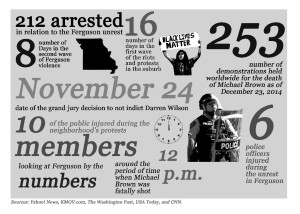Looking at the lessons from Ferguson over a year later
Tyler McNeil
Managing Editor
The aftermath of the Aug. 2014 fatal shooting of Michael Brown in Ferguson, Mo., continues to make waves across the country, including here at Hudson Valley.
Students react to a year of unrest after Ferguson
Last month, on the anniversary of Michael Brown’s death in Ferguson, Mo., police in riot gear and armored vehicles shared the streets with hundreds of protesters. Similar to last year’s unrest, after an 18-year-old was shot in the crowd by police, Ferguson was left in a state of emergency. “If anything, the issue has only been exacerbated, but that was just the tip of the iceberg,” said Megan Sherry, an individual studies student.
“There seems to be the same amount of police brutality since before Ferguson. People just talk about it more,” said Autumn Coogan, a business student.
Groups such as Black Lives Matter, which was created after the death of Trayvon Martin, have grown on the streets and online, attracting as many as 64 million followers on Twitter.
“I think in the last year a lot of things have changed, but I wouldn’t say it’s perfect. There’s more [bodycams] now and more awareness,” said Lex Alston, a theatre student.
Last May, the Department of Justice announced a $20 million pilot program for police body-cameras nationwide.
Despite growing awareness this year, in any given year, only six percent of police officers nationwide will have a complaint filed against them for misconduct. “Every police department will have one bad egg. It shouldn’t change the views of police in general,” said Mario Vasquez, a computer science student.
Business student Dante Bender was a passenger in a car pulled over by Saratoga police over the summer for going over the speed limit. Bender, who is black, was asked for identification, while the white driver was not.
“They said, ‘Sorry, you’re not that person,’ and I was like, ‘Dude, I was in the back of the car,’” he said.
According to a federal report, blacks are two times more likely to be searched during a traffic stop than whites but are 26 percent less likely to have contraband found on them during a search.
Tensions close-by
On Oct. 16, 2013, then-Hudson Valley football player Archie Davis and three friends were confronted by police for jaywalking in downtown Troy, resulting in an altercation which led to an assault by arresting officers, according to a claim. A $60,001 settlement ordinance for the case was later approved by the Troy City Council in favor of Davis against the three officers involved in the incident, Russell Clements, Isaac Bertos, and Dominick Comitale.
On the morning of Jan. 25, 2014, six out of eight officers were hospitalized after raiding the now-closed Kokopellis nightclub in downtown Troy, responding to an assault. Many witnesses at the scene, including the nightclub’s owners, have argued that police used excessive force against patron Roshawon Donley, who was arrested for assault at the scene.
Public response to the incident made waves from the streets of downtown Troy to Hudson Valley. Eleven days after the incident, pastor Willie Bacote organized a march against police brutality, with nearly 100 people walking down 5th Avenue in downtown Troy to Christ Church United Methodist.
At Hudson Valley, a forum on police brutality with panelists Campus Minister Cylon George, Director of Public Safety Fred Aliberti, and Captain of the Internal Affairs Bureau at the Troy Police Dept. Terry Buchanan took place less than two months after the incident.
The structural forces behind Ferguson
“The experiences in Ferguson provided an opportunity to try to understand the structural conditions that create the conditions that lead to these confrontations,” said SUNY Buffalo professor Henry Louis Taylor, who will discuss the forces of structural racism that leave black neighborhoods such as Ferguson underdeveloped this Tuesday, Sept. 15.
His presentation “The Four Horsemen of Structural Racism: Income Inequality, the Changing Structures of Cities, the Underdevelopment of Black Neighborhoods and Individual White Racism – and How They Relate to the Ferguson, Missouri Case” will be given in the BTC auditorium at 1 p.m. It is part of a larger research project the professor is currently working on that focuses on how the forces of urbanization act as a cause of tension between minorities and law enforcement in low-income neighborhoods.
Between 1950 and 1970, as a product of urban renewal, blacks migrated into St. Louis suburbs such as Ferguson. As a result, over the last 40 years, the white population in Ferguson has fallen from 99 percent to 29 percent, which, according to Taylor, triggered problems such as income inequality and housing abandonment after foreclosures in the 2007-2009 subprime mortgage crisis. According to Taylor, as the neighborhood’s population declines and grows poorer, its socioeconomic needs increase.
“What happened in Ferguson is part of a drama that has occurred in many other parts of the country,” said Taylor.

